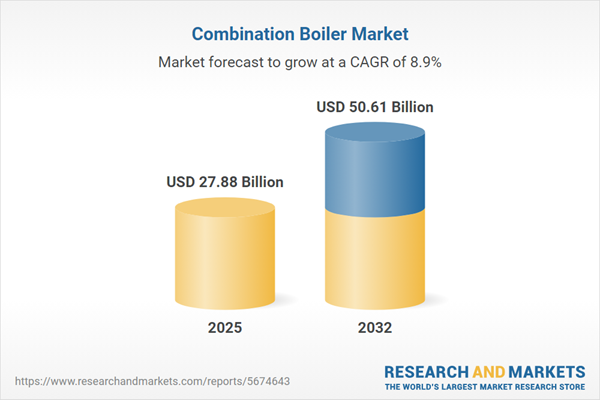Speak directly to the analyst to clarify any post sales queries you may have.
The combination boiler market is rapidly evolving as sustainability mandates, smart technologies, and shifting policies drive new opportunities and challenges for manufacturers and stakeholders globally. Senior leaders must understand emerging dynamics and actionable strategies to secure market advantage.
Market Snapshot: Growth and Momentum
The combination boiler market grew from USD 25.59 billion in 2024 to USD 27.88 billion in 2025, demonstrating robust demand. Continuing at a CAGR of 8.89%, it is expected to reach USD 50.61 billion by 2032.
Market momentum is driven by urbanization, heightened efficiency regulations, and a growing preference for compact, integrated heating solutions. Regulatory incentives, consumer demand for smart features, and ongoing technology advancements are deepening market penetration across commercial, residential, and industrial sectors.Scope & Segmentation
- Fuel Types: Gas (Biogas, Natural Gas), LPG (Butane, Propane), Oil (Diesel, Heavy Fuel Oil)
- Product Types: Floor Mounted, Wall Mounted
- Technologies: Condensing (Modulating, On/Off), Non-Condensing (Atmospheric, Fan Assisted)
- End Users: Commercial (Industrial, Institutional), Residential (Multi Family, Single Family)
- Capacities: Large, Medium, Small
- Distribution Channels: Direct Sales (Builder, Contractor), OEM (Branded, White Label), Retail (Offline, Online)
- Regions: Americas (North America, Latin America), Europe Middle East & Africa (Europe, Middle East, Africa), Asia-Pacific (China, India, Japan, Australia, South Korea, Indonesia, Thailand, Malaysia, Singapore, Taiwan)
- Key Companies: Vaillant GmbH, Viessmann Werke GmbH & Co. KG, Worcester Heating Group Limited, Ariston Thermo S.p.A, Baxi Heating UK Limited, Ferroli S.p.A., Robert Bosch GmbH, Navien Inc., Rinnai Corporation, BDR Thermea B.V
Key Takeaways
- Combination boilers now stand at the intersection of sustainability, urbanization, and digitalization, offering integrated solutions for both heating and hot water.
- Environmental policies are prompting advancements in condensing technology and alternative fuel readiness, including hydrogen blends and biogas adoption.
- Smart home integration and real-time monitoring are transforming service models, extending equipment life, and enabling predictive maintenance throughout equipment fleets.
- Agility in manufacturing and supply chain adaptation are increasingly critical as trade changes and component availability influence cost structures and sourcing decisions.
- Localized marketing, product configuration, and regulatory alignment remain essential due to varied building codes, energy infrastructure, and customer preferences worldwide.
Tariff Impact: Strategic Responses and Supply Chain Adjustments
The 2025 United States tariffs on imported steel, alloy components, and boiler subassemblies are impacting supply chains and procurement across the combination boiler industry. Manufacturers are adapting through near-shoring, material substitution, and local sourcing where possible. These measures are leading to contract renegotiations, longer lead times, and new operational efficiencies as organizations seek to preserve pricing stability and secure regional supply reliability. In North America, a notable increase in domestic manufacturing and fabrication is reshaping supplier relationships and supporting agile strategic planning.
Methodology & Data Sources
This analysis is built on primary interviews with C-suite executives, engineers, and facility managers, paired with comprehensive secondary sourcing from regulatory filings, technical documentation, and verified industry data. Advanced data analytics—including scenario modeling and cluster analysis—underscore the findings and ensure rigor. Expert panels and anonymized distributor feedback were integrated to maintain insight depth and accuracy.
Why This Report Matters
- Enables leaders to identify and capitalize on segmented growth opportunities in a rapidly evolving marketplace.
- Guides strategy on technology adoption, portfolio management, and regional expansion, aligning with global decarbonization and digitalization trends.
- Supports risk mitigation and resilience planning in light of tariff changes, regulatory shifts, and complex supply chain dynamics.
Conclusion
The combination boiler market offers significant growth potential for organizations adept at leveraging sustainable fuel options, advanced condensing technology, and smart ecosystem integration. Forward-looking strategies and adaptive supply chain practices will secure leadership amid changing market and regulatory landscapes.
Additional Product Information:
- Purchase of this report includes 1 year online access with quarterly updates.
- This report can be updated on request. Please contact our Customer Experience team using the Ask a Question widget on our website.
Table of Contents
3. Executive Summary
4. Market Overview
7. Cumulative Impact of Artificial Intelligence 2025
Companies Mentioned
The companies profiled in this Combination Boiler market report include:- Vaillant GmbH
- Viessmann Werke GmbH & Co. KG
- Worcester Heating Group Limited
- Ariston Thermo S.p.A
- Baxi Heating UK Limited
- Ferroli S.p.A
- Robert Bosch GmbH
- Navien Inc.
- Rinnai Corporation
- BDR Thermea B.V
Table Information
| Report Attribute | Details |
|---|---|
| No. of Pages | 193 |
| Published | October 2025 |
| Forecast Period | 2025 - 2032 |
| Estimated Market Value ( USD | $ 27.88 Billion |
| Forecasted Market Value ( USD | $ 50.61 Billion |
| Compound Annual Growth Rate | 8.8% |
| Regions Covered | Global |
| No. of Companies Mentioned | 11 |









